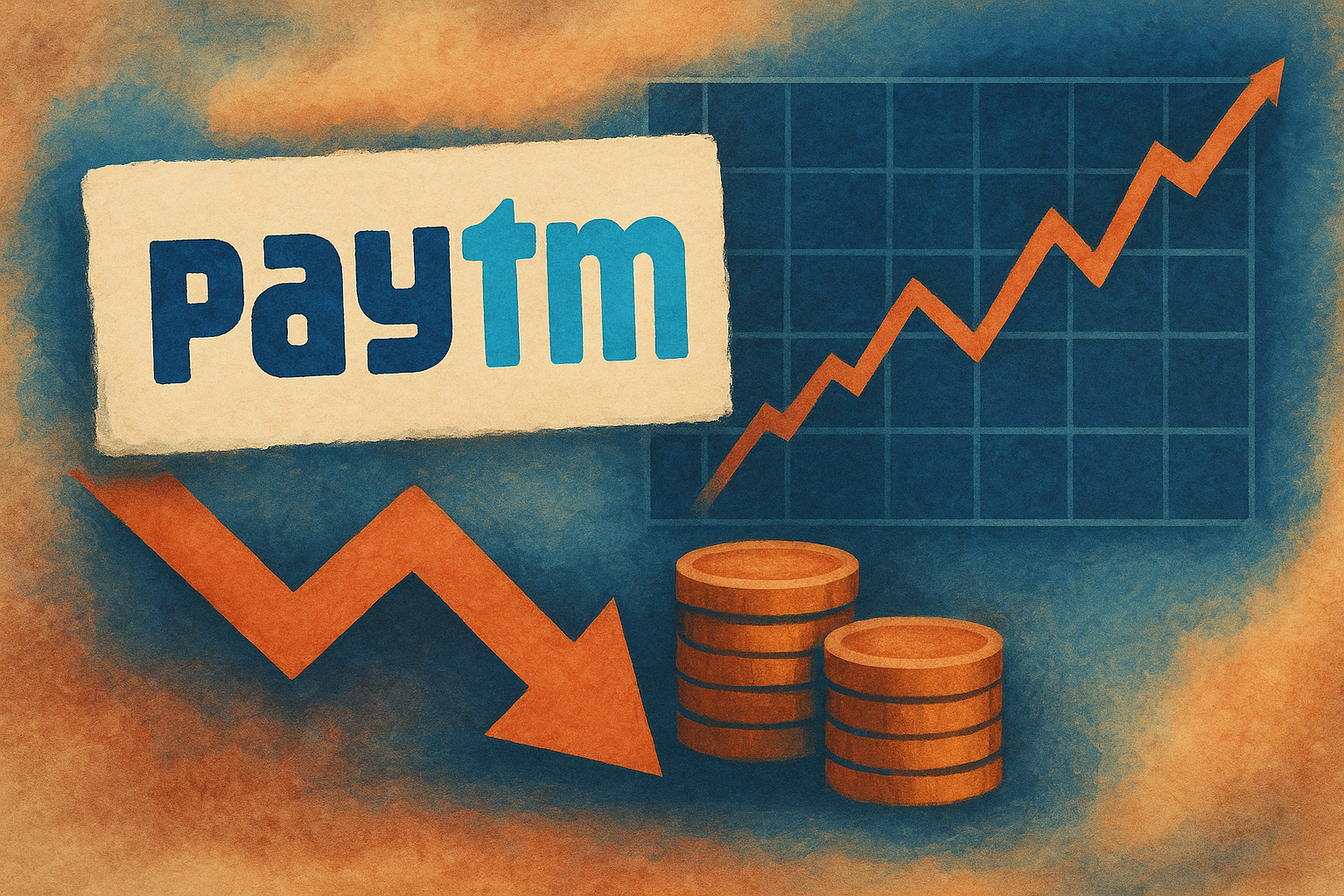Paytm’s journey over the last few years has been nothing short of dramatic—a tale of ambition, regulatory setbacks, near collapse, and an ongoing revival. Once the poster child of India’s fintech revolution, the company has weathered massive stock price erosion, a slew of RBI restrictions, and dwindling investor confidence. Yet, as of mid-2025, it appears to be scripting a comeback story, albeit with many challenges still ahead.
The Rise and the Fall
In November 2021, Paytm became the first fintech company to list on Indian bourses, raising a massive ₹18,000 crore through its IPO. But what followed was brutal—its stock price plummeted nearly 80% in under three years, wiping out billions in market capitalization.
Regulatory troubles were at the heart of this downfall. Paytm Payments Bank, launched in 2017, soon attracted the Reserve Bank of India’s (RBI) scrutiny for lapses in customer verification and data privacy practices. Repeated restrictions on customer onboarding, penalties, and ultimately a near-total ban on banking operations in January 2024 brought the company to its knees.
With no fresh deposits allowed, lending partners backing off, and the National Highways Authority banning FASTag issuance, Paytm’s core business was gutted. Industry players and investors largely wrote off the company.
Regulatory Concerns and the China Angle
The RBI’s concerns weren’t merely operational. The regulator worried about the intertwined finances and data flows between Paytm Payments Bank and its parent company, One97 Communications—partly backed by China’s Ant Financial.
Given geopolitical tensions after the 2020 Galwan Valley clashes, the lack of a clear operational firewall between Paytm and its Chinese-linked parent added to regulatory discomfort. Multiple warnings failed to bring about the necessary structural separation, culminating in the severe regulatory crackdown.
Survival Mode and Strategic Shifts
Despite the crisis, Paytm acted swiftly to retain its customer base. By March 2024, it secured a third-party application provider (TPAP) licence, enabling it to resume UPI services through partner banks. Merchant acquisition accelerated sharply, expanding its merchant base from 39 million in late 2023 to 45 million by mid-2025.
Cost-cutting became another survival pillar. Paytm downsized non-core businesses like ticketing and e-commerce, reduced marketing spends, leveraged AI for efficiency, and even sold Paytm Insider to Zomato (now Eternal) for a one-time gain.
Return to Profitability
The results began showing by FY26. Paytm reported its first-ever quarterly profit after tax (PAT) of ₹123 crore in Q1 FY26, with operational costs sharply reduced and ESOP-related expenses largely behind it.
Meanwhile, regulatory relief trickled in—RBI granted a payment aggregator licence, NPCI allowed fresh UPI customer onboarding, and Ant Financial fully exited One97 Communications. Founder Vijay Shekhar Sharma’s entity, Resilient Asset Management, emerged as the largest shareholder, giving the company more operational independence.
Challenges Ahead
Despite these wins, Paytm’s road to full recovery remains steep.
- Monthly transacting users have dropped from 100 million in late 2023 to 74 million in mid-2025.
- Revenues are still below pre-crackdown levels, with Q1 FY26 revenue at ₹2,000 crore versus nearly ₹2,900 crore in December 2023.
- The credit business has slowed, partly due to industry-wide concerns around small-ticket lending.
- Rumors persist about indirect Chinese influence via financial instruments like optionally convertible debentures.
While cost rationalization has restored profitability, revenue diversification—through wealthtech, international expansion, and financial services—remains years away from meaningful scale.
The Road Ahead
For now, Paytm’s comeback story hinges on three pillars:
- Regulatory Stability – With major licences reinstated, maintaining compliance and avoiding future run-ins with the RBI is critical.
- Merchant and Customer Reacquisition – Winning back lost ground in UPI and digital payments will define Paytm’s medium-term growth.
- Revenue Diversification – Scaling financial services, lending, and new-age businesses will decide whether profitability sustains beyond cost-cutting measures.
With its stock price recovering past ₹1,000 per share and investor sentiment improving, Paytm appears to have put the worst behind it. But true redemption will require not just regulatory peace but also robust revenue growth—a challenge Paytm is yet to fully conquer.
Feel free to share your experiences and insights in the comments below. Let’s continue the conversation and grow together as a community of traders and analysts.
By sharing this experience and insights, I hope to contribute to the collective knowledge of our professional community, encouraging a culture of strategic thinking and informed decision-making.
As always, thorough research and risk management are crucial. The dynamic nature of financial markets demands vigilance, agility, and a deep understanding of the tools at your disposal. Here’s to profitable trading and navigating the election season with confidence!
Ready to stay ahead of market trends and make informed investment decisions? Follow our page for more insights and updates on the latest in the financial world!
For a free online stock market training by Yogeshwar Vashishtha (M.Tech IIT) this Saturday from 11 am – 1 pm, please sign up with https://pathfinderstrainings.in/training/freetrainings.aspx
Experience profits with my winning algo strategies – get a free one-month trial with ₹15 lakh capital! – https://terminal.algofinders.com/algo-terminal
Disclaimer
This article should not be interpreted as investment advice. For any investment decisions, consult a reputable financial advisor. The author and publisher are not responsible for any losses incurred by investors or traders based on the information provided.


